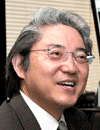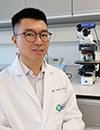Co-Located Conference AgendasFlow Chemistry Asia 2023 | Lab-on-a-Chip and Microfluidics Asia 2023 | 

Thursday, 5 October 202308:00 | Conference Registration, Materials Pick-Up, Coffee and Tea in the Exhibit Hall | |
Session Title: Conference Opening Session |
| | |
Session Chairperson: Dr. Claudia Gärtner, CEO microfluidic ChipShop GmbH Germany |
| | 09:00 |  | Conference Chair Welcome and Introduction by Conference Chairperson: Emerging Themes in Microfluidics 2023
Claudia Gärtner, CEO, microfluidic ChipShop GmbH, Germany
|
| 09:30 |  | Keynote Presentation Nanobiodevices, Quantum Life Science, and AI for Future Healthcare
Yoshinobu Baba, Professor, Nagoya University, Japan
We have investigated nanobiodevices, quantum life science, and AI for biomedical applications and healthcare. Nanowire devices are extremely useful to isolate extracellular vesicles from body fluids and vesicle-encapsulated microRNA analysis. The device composed of a microfluidic substrate with anchored nanowires gives us highly efficient collections of extracellular vesicles in body fluids and in situ extraction for huge numbers of miRNAs (2,500 types) more than the conventional ultracentrifugation method. Nanowire devices gave us the miRNA date for several hundred patients and machine learning system based on these miRNA data enabled us to develop the early-stage diagnosis for lung cancer, brain tumor, pancreas cancer, liver cancer, bladder cancer, prostate cancer, diabetes, heart diseases, and Parkinson disease. Nanowire-nanopore devices combined with AI (machine learning technique) enable us to develop mobile sensors for SARS-CoV-2, PM2.5, bacteria, and virus in the environment. MEXT Quantum Leap Flagship Program (Q-LEAP), which I lead, has been developing biological nano quantum sensors, quantum technology-based MRI/NMR, and quantum biology and biotechnology. Nanodiamonds, with nitrogen-vacancy centers, and quantum dots are applied to develop quantum sensors for quantum switching intra vital imaging for iPS cell (induced pluripotent stem cells) based regenerative medicine, and quantum photo immuno-therapeutic devices for cancer. Multifunctional quantum nanoparticles were developed for fluorescence/MR bimodal in vivo imaging-guided potothermal-intensified chemodynamic synergetic therapy of targeted tumors. |
| 10:15 |  | Keynote Presentation Microfluidic Approaches to Isolating Micro- and Nanoscale Circulating Biomarkers for Cancer Diagnosis and Monitoring
Chwee Teck Lim, NUS Society Chair Professor, Department of Biomedical Engineering, Institute for Health Innovation & Technology (iHealthtech), Mechanobiology Institute, National University of Singapore, Singapore
Microfluidics has emerged as a powerful technology not only for biological but also clinical research and applications. For example, the ability to manipulate and analyse minute volume of fluids and samples has led to a wealth of new biological assays which can provide unique approaches for better manipulation and capture of micro- and even nanoscale circulating biomarkers such as cells, extracellular vesicles and exosomes. With these new tools, researchers are not only being led to new questions and discoveries, but also applications in disease diagnosis, monitoring and even therapy. Here, I will present several microfluidic technologies that we have developed for both biological and clinical applications relating to diseases such as cancer. These includes microfluidic chips for rare diseased cell separation and culture as well as capture of extracellular vesicles and exosomes.
|
| 10:45 | Mid-Morning Coffee and Tea Break and Networking in the Exhibit Hall | 11:15 |  | Keynote Presentation Chemically Programmable Isothermal PCR Enables Rapid Nucleic Acid-based Bioanalysis at the Point of Need
Victor Ugaz, Professor & Interim Department Head, Texas A&M University, United States of America
The polymerase chain reaction (PCR) and its variants are analytical gold standards for nucleic acid-based testing that play a critical role in diagnosing and monitoring infectious diseases. But robust portable PCR-based testing at the point of need (PON) remains elusive, especially in resource-limited settings, because the required thermocycling instrumentation is neither amenable to nor validated for operation in a portable format. This presentation describes a microfluidic platform that overcomes these barriers by exploiting the ability to perform isothermal PCR via natural convection. We apply “chemical programming” to manipulate the interplay between the PCR biochemistry and the microscale convective flow field, enabling 100% repeatability to be achieved in a format that can be easily and cost-effectively manufactured, dramatically increasing simplicity, portability, and affordability. We demonstrate rapid replication of targets associated with multiple pathogens, including SARS-CoV-2, attaining performance rivaling ultra-fast PCR instruments while using lower reagent concentrations than conventional protocols. This discovery paves the way for widespread adoption of PCR-based analysis at the PON, making it possible to bring lab-quality diagnostics to decentralized settings. |
| 11:45 |  | Keynote Presentation Emerging Trends in Microfluidics Inspired by Nature
Anderson Shum, Professor, Department of Mechanical Engineering; Director, Advanced Biomedical Instrumentation Centre, University of Hong Kong, Hong Kong
The field of microfluidics has led to a wide variety of advances in bioanalyses, fluid characterization, materials design and many other applications. Microfluidics is now commonly used as a tool well integrated into the final application. Further development of the field of microfluidics requires new ideas in the design of the microfluidic devices and strategies in general. In this talk, I will discuss a few potential trends in the devices, for instance, by making the devices more responsive to the environment, enhancing the exchange of materials with the micro-environment and extending to a wider range of fluids. The resultant devices enable microfluidics to capture advantages and features that are often observed in Nature, such as in plants, vasculature, and cellular environment. |
| 12:15 | 3D Printed Microfluidic Gadget for Biomedical Daily Grind: From Culturing Tumor Spheroids to Niche Recapitulation
Liang Zhao, Associate Professor, Beijing University of Technology, China
Looking back the history of the microfluidics’ development, all the key surging points was initiated from the application of new fabrication modality, such as soft-lithography-based prototyping, which revolutionized this field by greatly lowering the accessibility of microfabrication. We believe the trend for lowering and democratizing the fabrication process should keep going on because biologists begin to harness the microengineering technologies to address the problems during biological experiments such as building and recapitulating organ-like functions on a transparent circuit with highly temporal-spatial controllable way. Herein we present an easy operating microfluidic physiological system that enables liver-tumor spheroids interactions within a 3D printing-cast-based microfluidic chip, recapitulating the liver-tumor microenvironment with an integrative format.
| 12:45 | Networking Luncheon in the Exhibit Hall -- Network with Exhibitors, View Posters and Engage with Colleagues. **Lunch is Japanese Bento** | |
Session Title: Lab-on-a-Chip and Microfluidics -- Current Landscape and Applications Segments |
| | 14:00 |  | Keynote Presentation RNA Sequencing using a Nanofluidic Device with Dual In-Plane Nanopore Sensors
Steve Soper, Foundation Distinguished Professor, Director, Center of BioModular Multi-Scale System for Precision Medicine, The University of Kansas, United States of America
With the development of next generation sequencing (NGS), the field of transcriptomics has seen tremendous advancements opening up opportunities for improved diagnostics of diseases such as cancers and infectious diseases. RNA sequencing enables measurement of single nucleotide variants (SNVs), insertions and deletions, detection of different transcript isoforms, splice variants, and chimeric gene fusions. Although NGS has been useful for unraveling RNA structure and function, several technical difficulties remain including the need for reverse transcription and PCR amplification, which can mask epitranscriptomic modifications. To address NGS issues, we are developing an exciting new sequencing technology called Exonuclease Time-of-Flight (X-ToF) for the label-free detection and identification of single molecules. The hypothesis behind X-ToF is, “individual molecules moving electrokinetically through a 2D nanotube will experience a time-of-flight (ToF) that is dependent upon its molecular identity.” X-ToF is a nanofluidic device comprised of input/output channels, a nano-scale enzymatic bioreactor, and a flight tube equipped with a pair of in-plane nanopores to measure the ToF of a single ribonucleotide monophosphate (rNMP). Each rNMP is produced from an unamplified RNA molecule using a processive exoribonuclease, XRN1. In this presentation we will discuss the high rate manufacturing of the X-ToF chip with sub-5 nm in-plane nanopores using nano-injection molding from a cyclic olefin polymer (COP) plastic. The in-plane pores are situated at either end of a nanochannel (50 x 50 nm; 5 µm long) that generate current transient signals to detect and deduce the identity of rNMPs. The ToF is dependent on the apparent electrophoretic mobility of the molecule. The identity is determined from the ToF, the current transient amplitudes, and dwell times using multi-parameter Principle Component Analysis (PCA). We will show the ability to detect (detection efficiency ~100%) single rNMPs with identification accuracies >98%. Finally, we will discuss the generation of solid-phase nano-bioreactors using XRN1, which can cleave ssRNA in the 5’ to 3’direction releasing rNMPs. Unique properties of the immobilized enzyme will be presented in terms of its processivity and kinetic rate of cleaving single RNA molecules. |
| 14:30 |  | Keynote Presentation Droplet-Based Microfluidics to Detect Cancer Circulating Biomarkers: From Technology Development to Clinical Validation
Valérie Taly, CNRS Research Director, Professor and Group leader Translational Research and Microfluidics, Université Paris Cité, France
Droplet-based microfluidics has led to the development of highly powerful tools with great potential in High-Throughput Screening where individual assays are compartmentalized within aqueous droplets acting as independent microreactors. Thanks to the combination of a decrease of assay volume and an increase of throughput, this technology goes beyond the capacities of conventional screening systems. Added to the flexibility and versatility of platform designs, such progresses in the manipulation of sub-nanoliter droplets has allowed to dramatically increase experimental level of control and precision. The presentation will aim at demonstrating through selected example, the great potential of this technology for biotechnology and cancer research. First, we will show how by combining microfluidic systems and clinical advances in molecular diagnostic we have developed an original method to perform millions of single molecule PCR in parallel to detect and quantify a minority of target sequences in complex mixture of DNA with a sensitivity unreachable by conventional procedures. Technological development allowing for the multiplex detection of cancer biomarkers will be presented. The presentation will also illustrate the pertinence of the developed procedures to overcome clinical oncology challenges, the results of several clinical studies will be presented. In particular, applications of droplet-based digital PCR to the follow-up of both advanced and localized cancers will be presented. |
| 15:00 |  | Keynote Presentation New Opportunities to Detect Disease and Probe Microbials Using Lab-on-a-Chip Devices
Amy Shen, Professor and Provost, Okinawa Institute of Science and Technology Graduate University, Japan
Microfluidics and lab-on-a-chip devices have emerged as powerful platforms to manipulate fluids at small length-scales and open up new possibilities in biophysics and biotechnology research. In this talk, I will showcase two examples of using microfluidics for microbial population research and disease diagnosis.
- A microfluidic device with controlled microenvironment is developed to study population genetics: many microbial populations proliferate in small channels. In such environments, reproducing cells organize in parallel lanes. Reproducing cells shift these lanes, potentially expelling other cells from the channel. We combine theory and experiments to understand how these dynamics affects the diversity of a microbial population.
- The rapid transmission and resilience of COVID-19 have led to urgent demands in monitoring humoral response for effective vaccine development, thus a multiplex co-detection platform to discriminate infection-induced from vaccine-induced antibodies is needed. A duplex electrochemical immunosensor for co-detection of anti-nucleocapsid IgG (N-IgG) and anti-spike IgG (S-IgG) is developed by using a two-working electrode system, via an indirect immunoassay, with antibody quantification obtained by differential pulse voltammetry. This duplex immunosensor is then integrated in a microfluidic device to obtain significantly reduced detection time < 7 min) while maintaining its analytical performance. Our duplex microfluidic immunosensor can be easily expanded into multiplex format to achieve high throughput screening for the sero-surveillance of SARS-CoV-2 and other infectious diseases.
|
| 15:30 | Mid-Afternoon Coffee and Tea Break and Networking in the Exhibit Hall | 16:00 |  | Keynote Presentation Node-Pore Sensing: A Versatile Method to Phenotype Single Cells
Lydia Sohn, Almy C. Maynard and Agnes Offield Maynard Chair in Mechanical Engineering, University of California-Berkeley, United States of America
We have developed an electronic method to screen cells for their phenotypic profile, which we call Node-Pore Sensing (NPS). NPS involves using a four-terminal measurement to measure the modulated current pulse caused by a cell transiting a microfluidic channel that has been segmented by a series of inserted nodes. Previously, we showed that when segments between the nodes are functionalized with different antibodies corresponding to distinct cell-surface antigens, immunophenotyping can be achieved. By simply inserting between two nodes a straight “contraction” channel through which cells can squeeze, we can mechanophenotype single cells, simultaneously measuring their size, resistance to deformation, transverse deformation, and ability to recover from deformation. When the contraction channel is sinusoidal in shape, resulting in cells being periodically squeezed, mechano-NPS can also measure the viscoelastic properties of single cells. I will describe how we have used NPS to distinguish chronological age groups and assess breast cancer susceptibility in women.
|
| 16:30 |  | Keynote Presentation Modular Design of 3D Printed Microfluidics for Bioprocess Applications
Noah Malmstadt, Professor, Mork Family Dept. of Chemical Engineering & Materials Science, University of Southern California, United States of America
As 3D printing replaces traditional clean room manufacturing for microfluidic engineering applications, it’s becoming clear that this transition offers not only lower cost and faster design iterations, but also new opportunities for fluidic routing and control that are only possible due to the inherent three-dimensional nature of these systems. Over the past several years, we have developed design principles that take advantage of this three-dimensionality, as well as demonstrating several applications that benefit from this approach. At the core of these design principles is the modularity of microfluidic unit operations. In addition to designing prototypical unit operations such as mixers, splitters, flow focusers, droplet generators, thermal and optical sensors, and world-to-chip interfaces, we have developed systematic approaches to combining these modules into microfluidic circuits with predictable behaviors. This approach can be used to rapidly prototype complex microfluidic operations by assembling physically distinct modules as well as to design monolithic microfluidic devices which can be printed in a single run. We have demonstrated the power of this approach by building several micro- and milifluidic systems for bio-analysis and bioprocess applications. These include systems for biomarker diagnostics, automated high-throughput affinity screening, and rapid manufacturing of vaccine lipid nanoparticles. We have also demonstrated how entire systems can be treated as modules, allowing for scaling of bioprocess production lines by massive parallelization. |
| 17:00 |  | Keynote Presentation Lab on a Particle Technology for Functional Discovery of Rare and Unconventional T-Cell Receptors
Dino Di Carlo, Armond and Elena Hairapetian Chair in Engineering and Medicine, Professor and Vice Chair of Bioengineering, University of California-Los Angeles, United States of America
Lab on a particle technologies are emerging as a rapidly adopted platform for performing single-cell functional screening leveraging standard instrumentation, such as flow cytometers and microfluidic single-cell sequencing platforms. Each cell and its secreted products can be analyzed and sorted using widely available fluorescence activating cell sorters operating at up to a 1000 cells per second, promising to democratize single-cell technologies. The platform enables sorting cells based on secreted products for the discovery of antibodies, the development of cell lines producing recombinant products, and the selection of functional cells for cell therapies. Here, I will describe our progress in using nanovial particles for the characterization and discovery of antigen-specific and metabolite-specific T cells. Nanovials enable selective binding, functional characterization of secretion of cytokines and other effector molecules, and sorting of T cells for downstream T-cell receptor sequencing and functional annotation. We apply oligo barcoding technology to both multiplex target antigens and functional performance and link this to the TCR sequence information. Nanovials can enable more rapid discovery of cancer-specific TCRs and TCRs against metabolites presented by unconventional MHC-like molecules, with high accuracy, promising to transform the discovery of critical recognition elements for improved T cell therapies. |
| 17:30 | Networking Reception in the Exhibit Hall with Japanese Beer and Sake | 18:30 | Close of Day 1 Conference Programming |
Friday, 6 October 202308:00 | Morning Coffee, Tea and Networking in the Exhibit Hall | 09:00 |  | Keynote Presentation Rapid and Signal Crowdedness-Robust In-Situ Sequencing through Hybrid Block Coding
Yanyi Huang, Professor, Peking University, China
Spatial transcriptomics technology has revolutionized our understanding of cell types and tissue organization, opening new possibilities for researchers to explore transcript distributions at subcellular levels. However, existing methods have limitations in resolution, sensitivity, or speed. To overcome these challenges, we introduce SPRINTseq (Spatially Resolved and signal-diluted Next-generation Targeted sequencing), an innovative in situ sequencing strategy that combines hybrid block coding and molecular dilution strategies. Our method enables fast and sensitive high-resolution data acquisition, as demonstrated by recovering over 142 million transcripts from 453,843 cells from four mouse brain coronal slices in less than two days. Using this advanced technology, we uncover the cellular and subcellular molecular architecture of Alzheimer's disease, providing unprecedented insights into abnormal cellular behaviors and their subcellular mRNA distribution. This improved spatial transcriptomics technology holds great promise for exploring complex biological processes and disease mechanisms. |
| 09:30 |  | Keynote Presentation Analytical Assays on Paper Platforms: As Simple as Possible
Daniel Citterio, Professor, Keio University, Japan
There is a continuously growing demand for analytical assays that can be performed on-site by minimally trained operators without the need for sophisticated laboratory equipment and reagent handling. In this context, (microfluidic) paper-based analytical devices (µ)PADs, including lateral-flow immunoassays (LFIAs), have gained significant attention, particularly for point-of-care testing in medical diagnostics. Over the past few years, we have demonstrated that certain analytical assays conventionally depending on benchtop instruments can be implemented into simple paper platforms not requiring any reagent handling. Examples include paper-based devices for the naked eye “calibration-free” colorimetric semiquantitative analysis of clinically relevant parameters that can be operated by minimally trained users with minimal risk of incorrect result misinterpretation. The presentation will also introduce one of our latest efforts towards boosting assay sensitivity on paper by adapting the CRISPR/Cas system to a paper-based analytical platform in the form of a simple, rapid, and highly sensitive detection method for non-nucleic acid targets by integrating CRISPR/Cas12a and an enzyme-linked immuno-sorbent assay (ELISA). |
| 10:00 |  | Keynote Presentation Functional 3D Printed Human Liver Discoids for Toxicology and Pharmacology
Thomas Angelini, Professor, Department of Mechanical and Aerospace Engineering, University of Florida, United States of America
A persistent challenge in drug discovery and development has been our inability to predict whether compounds induce liver injury in humans, leading to costly clinical development failures, blackbox warnings, or withdrawal of drugs from the market. This limitation is broadly encountered; tests using animal models, cell monolayers, and 3D culture approaches fail to predict drug induced liver injury (DILI). Thus, to reduce costs and accelerate the development of effective drugs, there is a critical need for improved human liver tissue models. In this talk I will describe an approach for 3D bioprinting functional human liver tissue models, in which we fabricate disc-shaped structures 200 ?m in thickness and 1-3 mm in diameter, embedded in a highly permeable support medium made from packed microgels. We demonstrate that the method is precise, accurate, and scalable; up to 100 tissues per hour can be manufactured with a variability and error in diameter of about 4%. Histologic and immunohistochemical evaluation of printed discoids reveal self-organization, cell cohesion, and key liver marker expression. During 3-4 weeks in culture, the tissues stably synthesize albumin and urea at high levels, outperforming spheroid tissue models. We find the tissues express more than 100 genes associated with molecular absorption, distribution, metabolism, and excretion (ADME) at levels within the range of human liver. Finally, the liver tissue models exhibit enzymatic formation of metabolites after exposure to multiple test compounds. Together, these results demonstrate the promise of 3D printed discoids for pharmacological and toxicological application. |
| 10:30 | Mid-Morning Coffee and Tea Break and Networking in the Exhibit Hall | 11:00 |  CYTOP® Fluoropolymer Hydrophobic Coatings For Digital Microfluidics and Biochip Application CYTOP® Fluoropolymer Hydrophobic Coatings For Digital Microfluidics and Biochip Application
Amandeep Jindal, Project Manager- Senior Product Development Researcher, AGC Inc. Japan
Digital microfluidics applications are at the forefront of enhancing precision in handling small liquid volumes, enabling diverse functions including medical diagnostics and chemical synthesis. The integration of a hydrophobic fluoropolymer layer becomes indispensable within these systems to enable precise control over droplet movement, prevent undesirable interactions, namely biofouling, and ensure the seamless flow of fluids. CYTOP®, with its highly favorable attributes including hydrophobicity and stability in devices for biochip applications, are used in mass-produced products; with its three available grades offering tailored functional groups: CYTOP®-A with carboxy terminals, CYTOP®-M with silane terminals, and CYTOP®-S with comprehensive fluoro-functional groups. It showcases CYTOP®’s strengths of recognized quality and characteristics, and its supply stability. This discussion highlights on the importance of digital microfluidics and the significance of CYTOP® in such digital microfluidics devices, showcasing its suitability and importance.
| 11:30 |  The Emerging Field of Organ-on-a-Chip - Technical and Business Considerations The Emerging Field of Organ-on-a-Chip - Technical and Business Considerations
Claudia Gärtner, CEO, microfluidic ChipShop GmbH
| 12:00 | Electrical Property Evaluation of Cells Based on Continuous-Flow Electrorotation
Masahiro Motosuke, Professor, Department of Mechanical Engineering, Tokyo University of Science, Japan
The electric properties of cancer cells reflect their types and drug resistance status. The electrorotation is a non-invasive and label-free technique to obtain the electrical properties of cells, conductivity and permittivity of cytoplasm or membrane, using image analysis of the rotational behavior of the cells under a rotating electric field. However, conventional electrorotation has issues with its low throughput due to difficulties of cell handling. Our research group has developed a novel electrorotation platform enabling multi-cell analysis under continuous-flow conditions. In the developed microfluidic system, the cells receive a vertically-rotating electric field and result in vertical rotation. We investigated the effectiveness of the vertical rotation analysis of cells and confirmed that the proposed electrorotaion device can be used for the measurement of the electrical properties of cancer cells. | 12:30 | Networking Luncheon in the Exhibit Hall -- Network with Exhibitors, View Posters and Engage with Colleagues. **Lunch is Japanese Bento** | |
Session Title: The Deployment of Microfluidics for Developing Microphysiological Systems (MPS), Organs-on-Chips |
| | 13:30 | Initiatives of AMED-MPS Projects for Industrial Implementation of MPS in Japan and Collaboration with Asia
Seiichi Ishida, Guest Researcher, National Institute of Health Sciences, Professor, Sojo University, Japan
AMED-MPS2 project started in 2022 and has been leading the initiative for the implementation of MPS originated in Japan to industries. Due to the unique nature of the culture environment of MPS, it has become clear that there are "points to consider" that differ from conventional culture methods in order to maintain healthy cell function,e.g. cell functionality, cell adhesion property, and medium perfusion conditions. Our efforts how to deal with such requirements for MPS industrial implementation will be introduced. Beyond these efforts will be the regulatory acceptance of the data obtained by MPS. Discussions what MPS should be as the test methods for regulatory usage based on the considerations will be presented, which are taking place in AMED MPS-RS (RS stands for “regulatory science”). MPS-RS has launched MPS Consortium for Industrial Implementation and Regulatory Acceptance, which gives the discussion table among four stakeholders, academia, supplier, end user, and regulator. The MPS Consortium are also collaborating with iMPSS, founded in this June, and its Asia-Pacific regional chapter. These activities will be presented. | 14:00 | MPS Platforms with High Operability for Commercialization
Hiroshi Kimura, Professor, Micro/Nano Technology Center, Tokai University, Japan
Microphysiological systems (MPSs) have been widely studied as a novel
method for estimating the effects and toxicities of drugs, providing an
alternative to animal tests in drug discovery. In EU and USA, various
types of MPS are commercially available by some companies, and more
recently, their practical application has been well promoted. Although
MPS has been actively researched in Japan, there has been almost no
practical MPS to date. Japan Agency for Medical Research and Development
(AMED) has conducted an MPS development project with the aim of
commercializing domestically produced MPS since 2017. Our research group
has developed two types of MPS, Fluid3D-X and Kinetic pump Integrated
Microfluidic Plate, for commercialization in collaboration with Japanese
manufacturing companies in the project. Our proposed MPSs are expected
to facilitate high quality cell-based assays in drug discovery and
biology due to their ease of use and high throughput. In this
presentation, I present the overview of these MPS’s functions and
examples of the drug evaluation studies using the MPSs. | 14:30 | The NIH Microphyiological Systems Program: In Vitro 3D Models for Safety and Efficacy Studies
Danilo Tagle, Director, Office of Special Initiatives, National Center for Advancing Translational Sciences at the NIH (NCATS), United States of America
Approximately 30% of drugs have failed in human clinical trials due to
adverse reactions despite promising pre-clinical studies, and another
60% fail due to lack of efficacy. A number of these failures can be
attributed to poor predictability of human response from animal and 2D
in vitro models currently being used in drug development. To address
this challenges in drug development, the NIH Tissue Chips or
Microphysiological Systems program is developing alternative innovative
approaches for more predictive readouts of toxicity or efficacy of
candidate drugs. Tissue chips are bioengineered 3D microfluidic
platforms utilizing chip technology and human-derived cells and tissues
that are intended to mimic tissue cytoarchitecture and functional units
of human organs and systems. In addition to drug development, these
microfabricated devices are useful for modeling human diseases, and for
studies in precision medicine and environment exposures. Presentation
will elaborate in the development and utility of microphysiologicals
sytems and in the partnerships with various stakeholders for its
implementation. | 15:00 | Microphysiological Systems (MPS) With Perfusable Vascular Network for Pharmacological and Organogenesis Applications
Ryuji Yokokawa, Professor, Department of Micro Engineering, Kyoto University, Japan
Microfluidic devices have been used to answer scientific questions in
many lifescience research fields. Microphysiological systems (MPS)
mimics the functions of human biological organs and can be used to
measure physiological functions that are difficult to measure on a
culture dish. We have employed two approaches to create the interface
between organ cells and vascular networks: a two-dimensional method in
which organ cells and vascular endothelial cells are co-cultured on a
porous membrane such as Transwell (2D-MPS), and a three-dimensional
method in which the spontaneous patterning ability of vascular
endothelial cells is utilized (3D-MPS). As an example of 2D-MPS, we
developed a renal proximal tubule model and a glomerular filtration
barrier model using iPSC-derived organoid cells, which enables us to
evaluate reabsorption, filtration, and nephrotoxicity. For 3D-MPS,
angiogenesis and/or vasculogenesis are utilized to anastomose a
fibroblast spheroid and tumor spheroids to create tumor
microenvironments to evaluate the efficacy of an anti-tumor drug under a
flow condition. We also developed an on-chip vascular bed to co-culture
with any kind of tissues that do not have enough angiogenic factors to
induce angiogenesis. It was applied to kidney and brain organoids for
evaluating the effect of vessels on their development. The vascular bed
chip enabled to culture a kidney organoid at the air-liquid interface
(ALI) that is required for nephrogenesis and to separately supply two
media for the organoid and vascular bed. Proposed assay platforms will
further contribute to realize pharmacological applications and to
understand in vivo organogenesis. We keep exploring how micro/nano
fabrications can deepen science at the interface between blood vessels
and organs. | 15:30 | Late-Afternoon Coffee, Tea and Networking in the Exhibit Hall | 16:00 | Aerosol Generation for Lung Delivery: a 95% Efficient Solution
Jackson Gum, Masters Research Student, Monash University, Australia
It is essential to provide an improved treatment solution to asthma and COPD patients; inhaler users struggle to effectively administer their dosage, resulting in wasted medication and potential side-effects. Inefficiencies in inhaler devices include generating aerosols of the wrong size; poorly timed patient breathing; and leftover fluid that cannot be delivered. PALM is a smart inhaler device which improves on all areas to create a more efficient device than anything on the market. A novel geometry for ultrasonic aerosol generation produced the ideal droplet distribution; It was experimentally determined that 95 percent of the droplets are 1-5 micrometres in diameter, which is the ideal size range for lung delivery. The mechanism for nebulisation follows capillary wave theory, where the wavelength on the fluid-air interface governs the mean droplet size, and can be controlled by changing the frequency of the piezo actuator. A theoretical model is presented for the expected mean droplet size and Fine Particle Fraction at actuation frequencies from 0.5 to 3 MHz and beyond, based on experimental results over the same range; this allows PALM to generate droplets with a mean size of 3-20 micrometres, improving respiratory treatments for a range of conditions and target areas. | 16:30 | Peptide Nucleic Acid/2D Hybrid Material for Ultrasensitive Enzyme-free Electrochemical Detection of microRNA
Muhsin Ali, Postdoc, King Abdullah University of Science and Technology , Saudi Arabia
MicroRNA (miRNAs) have become highly promising, minimally invasive biomarkers for a variety of pathologies, including cancer and neurodegenerative diseases. However, even with industry-recognized methods like RT-qPCR, their short lengths and low concentrations make them difficult to detect consistently. Here, we provide a novel electrochemical detection approach for microRNA that is devoid of amplification and enzymes and takes use of the specificity of custom Peptide Nucleic Acid (PNA) probes mounted on 2D nanomaterials. These latter materials are 2D nanomaterials with appealing characteristics for electrochemical biosensing, including high conductivity, large specific surface area, good biocompatibility, and crucially, high density of functional groups for biofunctionalization. MicroRNA have emerged as extremely promising minimally invPNAs. PNAs have garnered a lot of attention among xeno-nucleic acid oligomers because they have a better binding affinity, more sequence specificity, and greater stability than their native counterparts. The platform demonstrated tremendous potential in the development of point-of-care biosensors for microRNA and potentially other clinically relevant nucleic acids during the proof-of-concept studies by achieving high sensitivity (aM LOD), high specificity, and a large dynamic range (>6 orders of magnitude). This is, to our knowledge, the first demonstration of a hybrid system, which enables enzyme-free sequence-specific detection of miRNA-141 target biomarker. | 17:00 | Panel Discussion -- Emerging Themes in Microfluidics, Lab-on-a-Chip and Organs-on-Chips -- Moderated by Dr. Claudia Gärtner, CEO, microfluidic ChipShop GmbH
Claudia Gärtner, CEO, microfluidic ChipShop GmbH, Germany
| 18:00 | Close of Conference Programming |
|


 Add to Calendar ▼2023-10-05 00:00:002023-10-06 00:00:00Europe/LondonLab-on-a-Chip and Microfluidics Asia 2023Lab-on-a-Chip and Microfluidics Asia 2023 in Tokyo, JapanTokyo, JapanSELECTBIOenquiries@selectbiosciences.com
Add to Calendar ▼2023-10-05 00:00:002023-10-06 00:00:00Europe/LondonLab-on-a-Chip and Microfluidics Asia 2023Lab-on-a-Chip and Microfluidics Asia 2023 in Tokyo, JapanTokyo, JapanSELECTBIOenquiries@selectbiosciences.com